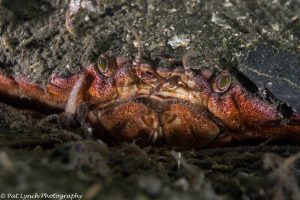Dungeness Crab
By Seattle Dive Tours Staff
Although Oregon State named this crab the state crustacean in 2009, just like all the other crabs, the “shell” of a Dungeness crab often ends up displayed as an ornament, decoration, or as a memento from a holiday at the beach. But this sideways walker deserves better attention, if for no other reason than because of their behavior – they
are great at camouflage and can easily blend into the surroundings. Also, if they feel threatened, they bury their head in the sand, or role onto the back, so they can bravely fight the enemy.
This crab bears the name of a small fishing village Dungeness in Washington State and it is classified under the Latin name Metacarcinus magister. They can be found in the muddy and sandy waters of North Pacific, from Alaska to California, or even Mexico. Recently, Dungeness crab have been found in the Atlantic Ocean which has raised concerns regarding dangers towards the local ecosystem. It is still not clear whether it is a result of climate changes, or a live crab was bought to the market, and later released into the wild.
They are easily identified by their long, oval and wide shell, which is purple or brown (when cooked, it turns orange). The shell is actually its exoskeleton which it molts as it grows. Being Arthropods, they have an exoskeleton instead of a spine, but they have five pairs of armored legs and several appendages such as two pairs of antennae for touch and smell, pincers used for tearing and defense. Females also have special appendages used for holding her eggs. If an appendage is lost – they are able to regenerate it.
Dungeness crab starts its mating season in late spring and it lasts usually till October. When female starts to molt, she is ready for mating. The female stores the sperm until eggs are developed, then she extrudes and carries them for 3-5 months before hatching. An adult female can carry up to 2.5 million eggs, and they tend to protect themselves by burying. After the hatching, they go through metamorphoses as younglings are planktonic and they swim away. They start turning into larvae at 4 months. They have 6 life stages and live approximately 10 years, but females live longer than males.
When young, these crabs tend to molt frequently. This process begins when crab starts absorbing water to expand its body. When the shell splits, crab finds shelter until the new shell hardens.
Although most crabs are omnivores, Dungeness crab are carnivores, feeding on worms, shrimp, clams, mussels and even small crabs and crab larvae, so cannibalism may occur.
Among seafood lovers, Dungeness crab is considered a delicacy because of its sweeter flavor and lack of ocean scent, so fishing is closely regulated. Possession and selling of female specimens are prohibited in the US, but nevertheless, their numbers are declining. Natural predators of Dungeness crab include sculpins, dogfish, octopus and other crabs, while salmon feed on their larvae.


